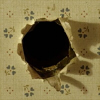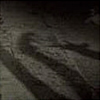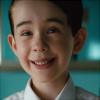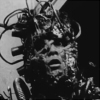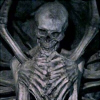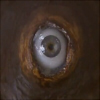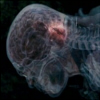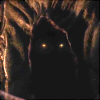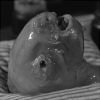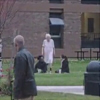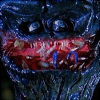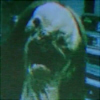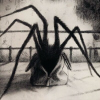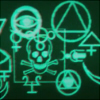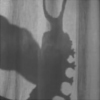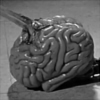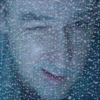By Jonathan Wojcik
ENTRY 27: FIEND WITHOUT A FACE
Questioning locals about any strange or suspicious activity, Cummings learns of the mysterious Professor R.E. Walgate, a British scientist who once specialized in the study of the human brain. Likely a bit of a laughingstock in certain academic circles, he would spend many years attempting unsuccessfully to prove the existence of telekinetic energy before finally retiring to the Canadian countryside, incidentally not far from the nuclear station, where he's said to have continued his research in private.
Cummings knows as well as we do that this guy has to be connected, and even if he isn't, there still can't be anyone more important to question about a hypothetical brain vampire than literally the only local brain scientist.
Direct Video Link
By now, the audience has seen multiple attacks by our culprit, and they continue to increase in frequency. The attacker is at this point in the film completely invisible, but we can tell from its interactions with objects that it's fairly small, that it crawls or slithers, that it can scale walls and that it can leap up onto human prey, who clutch at their heads and necks as though something is strangling them.
All the while, the presence of the creature is accompanied by a signature pulsing, slurping, wheezing sort of sound that I've never forgotten since the first time I saw this on Sci-Fi Channel at some point in the early 90's. It's haunting and grotesque, but it's also kind of satisfying and nice, isn't it? I feel like I could listen to that beat for hours.
He wouldn't have any success until a lightning storm provided an additional power surge, which finally enabled him to turn that single page even as it damn near fried his guts. Realizing he would need relatively enormous amounts of power to accomplish even the simplest telekinetic feats, he expanded his machine and escalated his experiments, somehow "building up a tolerance" to the constant electrocution as one does.
...But when did the professor's imaginary friend decide to drop that last "r?"
From the outside looking in, it's patently obvious that he was incrementally creating an independently conscious entity, but it's easy to imagine the thrill of discovery clouding his judgment. By the time it could cast off the shackles of his mind or his equipment, his creation had already become a brand new form of intelligent life, now free to follow the compulsion of a living thing to survive and multiply.
The professor has taught a concept of self to a thought, and it has gone feral.
BAD. ASS.
But the Fiends are still growing more powerful, especially as they learn to draw radiation directly from the plant's power core, and while this is admittedly kind of a step backwards for them, their increasing strength at last makes them "real" enough to be visible, and that's where the FUN begins.
Direct Video Link
It's plain to see the love that went into these animations, as the Fiends learn how to break in and run amok with visible intelligence and personality rarely seen in other "Bug Eyed Monsters." And as they crawl through furniture we can still see in other shots, it's apparent these were life sized stop motion models animated directly on-set, which is awesome.
You may also notice that the floor is covered over by a crappy tarp, crudely painted to kind of look like floorboards. That's probably because they weren't allowed to stain the real one with all those raspberry preserves gushing out of the injured monsters, which was incidentally considered graphic enough at the time to generate public outrage! It faced exceptional difficulty in Britain, where these scenes would be cut down significantly and still earn it an "X" rating. What little remained was derided nonetheless as a tastelessly gratuitous spectacle by London newspapers, and it was even discussed in parliament meetings as evidence of a moral decline. It's worth noting that we never actually see any human gore in the entire film, but the sight of all those realistic brains was widely considered nauseating in itself, let alone the sight of those brains bursting, squirting and sputtering with thick, clotted "blood!"
MONSTER ANALYSIS: THE FIENDS

Fiend Without a Face is another of those many horror films borne from the uncertainty of the nuclear age. The effects of radiation are still terrifying when you completely understand them, but at one time, an entire generation of adults could remember never, ever hearing that radioactive energy even existed when they were children, only to learn over the decades that this invisible force can cause birth defects, sterility, brain damage and terminal cancer, that it can leave soil and water catastrophically poisonous for centuries, that it can turn the population of a city to ash in the wrong hands and oh, yeah, this is also going to power the entire future of our civilization now. It's no surprise that the atom came to occupy the same niche in popular culture as wicked magic; the only meaningful difference is that this invisible force of plague and destruction is verifiably real.
But while countless nuclear-powered monsters, aliens and superheroes seem laughable through a more scientific lens, this instance still holds up amazingly well, perhaps because the radiation actually doesn't do anything unexplainable and truly only functions as an energy source in the correct sense of the term. It's the professor's electrical tulpa machine that's actually fantastical, but it's lent a funny sort of timelessness by the simple fact that psychic force isn't real enough to understand and demystify. We STILL make science fiction media about telekinetic powers, and popular culture still takes them as seriously as it did half a century ago. In fact, as we touched upon while reviewing The Empty Man, the idea of generating a living being from pure thought has only now really taken off as a more popular scenario in speculative fiction. These little brains were way ahead of both the zombie genre and the trending "tulpa" genre!
It's also ambiguous as to whether the brains of victims are actually becoming the additional Fiends themselves. A brain must evidently be consumed to create a new Fiend, yes, but then why does the new Fiend start out as invisible energy? Funny enough, it's implied that the creatures are only shaped like brains because that's how the professor personally visualized his original little buddy, but perhaps he only really did so because he was picking up on the entity's true shape? It seems as though the consumed brains are in fact destroyed altogether, but that the resulting Fiend remains a psychic after-image of the original biomatter; a "ghost" nervous system.
This also leaves us with the question of their actual sapience. In one sequence, we see that an invisible Fiend tries an actual doorknob first thing before resorting to forced entry, so there's at least some information that carries over from the original brain, and the professor speaks frightfully of their intelligence level. Could it even be that human minds are still in there? They don't act like it, but perhaps any hypothetical memory or personality they retain is simply overwhelmed by some irresistible fixation on making more Fiends. Perhaps they're even part of one collective mind with that original progenitor Fiend, losing their individuality and emotion as they blur into the same monstrously logical entity.
However inventive these adorable terrors already are and however they could be expanded upon, we must give credit where credit is really due, because they aren't wholly the invention of this film at all, or anybody directly involved in its production! In fact, despite how good a lot of it would ultimately turn out, director Arthur Crabtree was more or less contractually forced into the job and didn't even like monster movies, notoriously refusing to show up for the first few days of filming before he finally caved. If his name had to be on it, he'd be damned if he was going to let just anybody do his job; A director through and through, you have to admit.
Fiend Without a Face was really adapted from a 1930 short story, The Thought Monster, by author Amelia Reynolds Long, and as was tragically common for adaptations of literature at the time, this fact was never mentioned at all in any of the film's promotional material. You can find a full transcript of it here, and all the crucial details are already present, minus the military and the radiation and the hero fantasy. The original focus is much more on the professor's creation and documentation of a single "thought monster," which provided Fiend's most compelling storytelling anyway, and the eerie case of a partially "lobotomized" victim is actually its climax. Amelia never explicitly describes her monster, either, but a ghostly brain is a reasonable enough interpretation of something she does provide "slimy tendrils" as it probes its victim's thoughts, threatening to "draw their minds into its own!" That the movie expands on little else and even drops some details from the original narrative goes a long way to explain its inconsistent pacing, but it's more surprising just how much of this Hollywood adaptation DOES remain faithful to a short story written almost thirty years earlier.
We have Amelia to thank for a truly creative sci-fi horror antagonist, and everyone involved in "Fiend Without a Face" for translating that to a cinematic villain so enduring, we tend to misremember tentacled brains as a hallmark of the entire 50's monster boom, despite this being virtually the only true example, and one of the only "brain monster" 50's films at all alongside The Brain From Planet Arous, which hadn't a tentacle or eyestalk in sight! Once you know the Fiends, it's easy to see the mark they left on popular culture, with a number of obscure but lovable cameos and references over the decades. Among my favorites:
(Direct Link)
A "B-movie" watched by Hogarth in The Iron Giant, with obvious caricatures of Cummings and Barbara, and even the psychic energy explanation!
Direct Link
The Angry Beavers episode "Fakin' It," in which Norbert pretends to be sick and makes increasingly unreasonable (but in this case, highly understandable) demands. The brain-eating-brain is even still hanging around their house in subsequent scenes!
(Direct Link)
"Ren's Brain," one of those wholesome Ren and Stimpy episodes after John Kantpronounci was fired in case you were wondering, wherein Stimpy practices brain surgery on his boyfriend in an attempt to cure his stress and does a 10/10 bang-up job as we can see.
Direct Link
In the absolutely charming manga and OVA Space Family Carlvinson, one of the main characters is a dweeby alien whose design is little more than a Fiend with a few more more appendages added! I've also reviewed it before for another, even weirder cameo.
Direct Link
In Looney Tunes: Back in Action, an actual Fiend appears among many other classic monsters and aliens. A cameo so affectionate it recreates the Fiend's locomotion, sound effects and even attack method as it comes closer to murdering Brendan Frasier than many cinematic villains have ever dreamed of.
Since this special boy may have only so many years left in this world, I decided I should end this review treating him to his species' favorite activity: lurking and possibly sneaking in a cold northwestern forest.






















